7+ Best Website Optimization Tools for 2025
According to Forbes’s top website statistics for 2024, in the blink of 0.05 seconds, a potential customer decides to stay or leave your site. A well-optimized website is key to keeping them engaged, delivering an exceptional user experience, and driving results.
Website optimization enhances speed, usability, search engines visibility, and conversion rates to improve user satisfaction and business outcomes. That’s why it’s important to invest in website optimization tools that empower businesses to maximize their online presence and foster innovation in user engagement.
This guide delves into some top tools, covering how they help apply data-driven strategies and continuously refine websites to meet evolving expectations and goals.

What are website optimization tools?
Website optimization tools are software applications or online platforms designed to assist website owners, marketers, and developers in identifying and addressing areas for improvement on their websites.
These tools provide insights, analytics, and functionalities to optimize a website’s various aspects, such as speed, usability, search engine optimization (SEO), and conversion rates.
Different website optimization tools emerge based on their primary function or the specific area they aim to optimize. Some common types of website optimization tools include:
- Performance and speed optimization tools
- Usability and user experience (UX) tools
- Search engine optimization (SEO) tools
- Conversion rate optimization (CRO) tools
- A/B testing and experimentation tools
- Website monitoring and uptime tools
- Content optimization tools
- Web analytics tools
- Mobile website optimization tools
These tools often work in tandem, providing comprehensive insights and functionalities to optimize various aspects of a website effectively.
7 Best website optimization tools
Here are the seven best optimization tools across categories that can help you at any point of your website optimization journey.
1. VWO
VWO is a comprehensive conversion rate optimization platform designed to enhance digital experience. It allows CRO teams to conduct qualitative research to identify user pain points, run A/B tests to experiment with new experiences, and personalize interactions based on attributes like geography, age, and more.
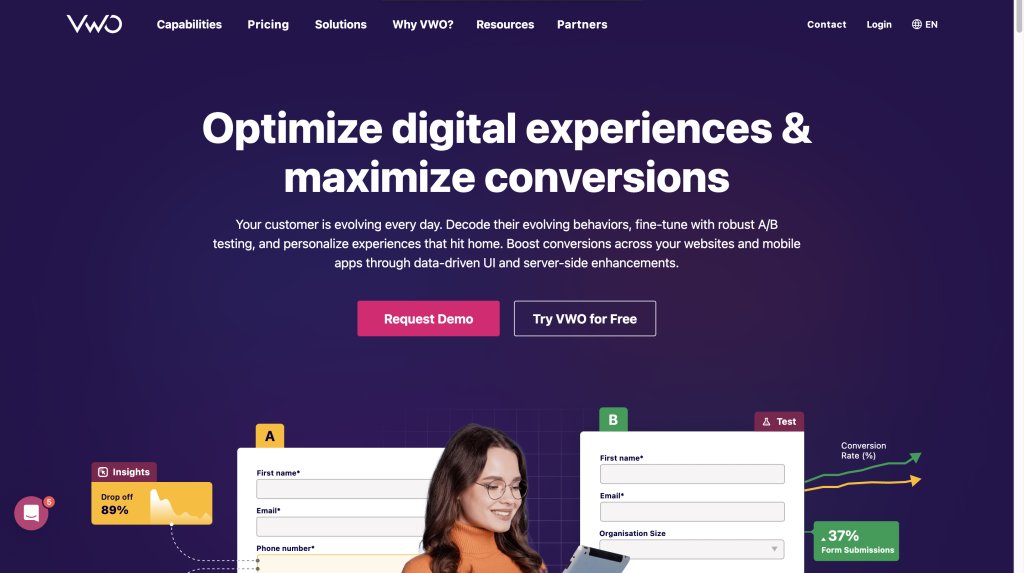
Feature
VWO provides robust tools to optimize digital experiences, including behavior analytics (heatmaps, session recordings, form analytics, and on-page surveys), web experimentation (A/B, multivariate, and split tests), and website personalization based on user attributes. It allows integration with 40+ digital platforms like Hubspot, WordPress, 6sense, and Acquia DM, among others. Also, it has a generative-based Copilot that analyzes heatmaps and session recordings, creates variations for A/B tests, and more.
Pricing
VWO’s pricing is tailored to specific capabilities:
- VWO Insights – Web (behavior analytics): Free starter plan for up to 5000 monthly tracked users (MTUs), with paid plans starting at $248 for 50,000 MTUs.
- VWO Testing – Web (web experimentation): Free starter plan for 50,000 MTUs; paid plans start at $275 for 50,000 MTUs.
- VWO Personalize (personalization): Free starter plan for 10,000 MTUs; paid plans start at $259 for 50,000 MTUs.
Pros
- Unified dashboard: Manage all CRO initiatives in one place, minimizing the need to switch between multiple tools.
- Generative AI automation: Automates manual tasks, saving time and improving accuracy.
- User-friendly interface: Simplifies project management, enhancing team collaboration and efficiency.
Success story
Serpent Forge, renowned for its quality men’s jewelry, collaborated with VWO to enhance its eCommerce experience. By clarifying payment options on product pages, Serpent Forge aimed to increase add-to-cart clicks.
Noticing customer confusion over the exclusive visibility of the PayPal installment option, Serpent Forge hypothesized a solution. They proposed that showcasing all payment methods—including Apple Pay, Google Pay, Mastercard, and Visa—near the add-to-cart button would streamline the checkout process.
A decisive A/B test involved over 2600 site visitors, comparing the original layout with a new version featuring multiple payment badges. The results were striking: the variation led to an 82% increase in add-to-cart clicks and a 32% boost in checkout page clicks, affirming the importance of clear payment information in enhancing the shopping experience.
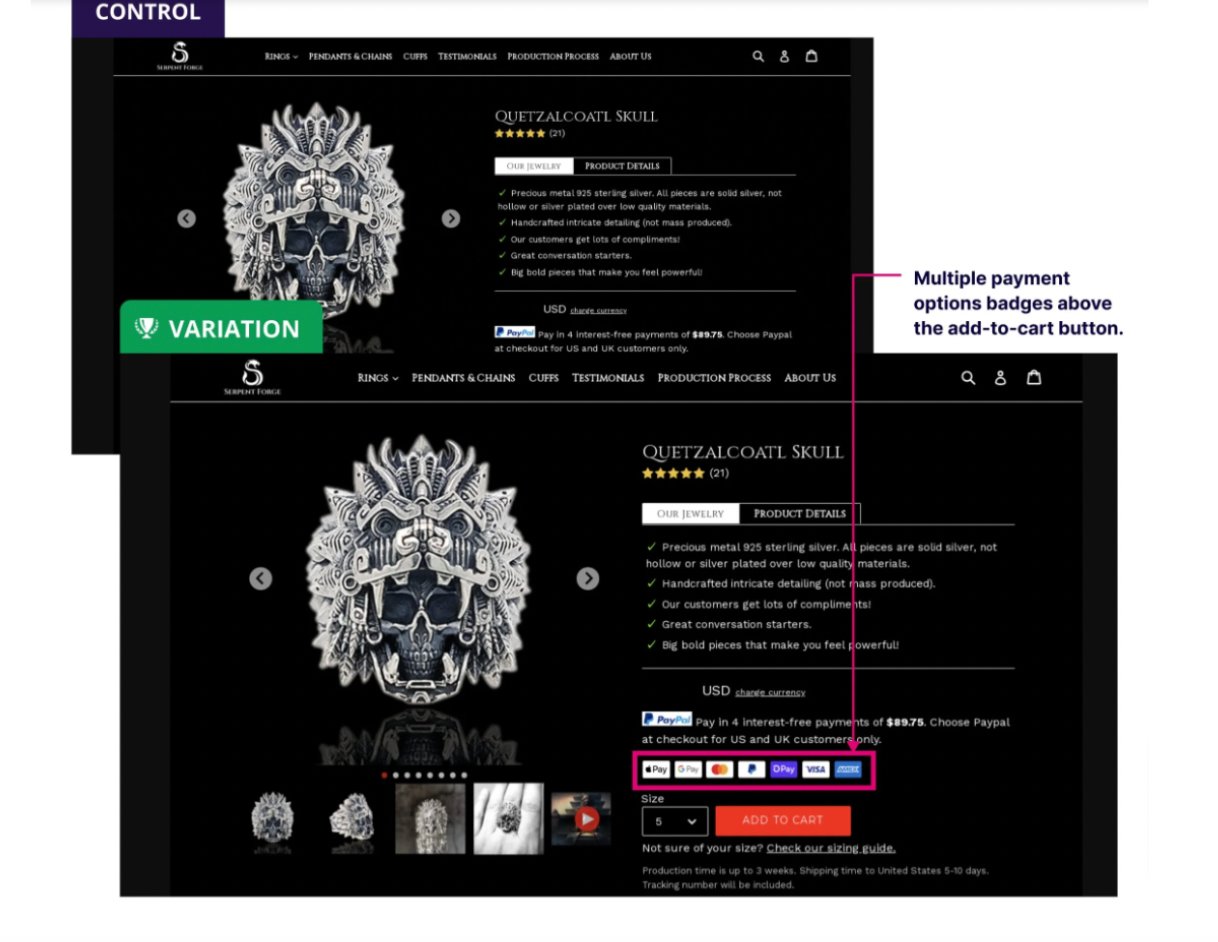
VWO empowered Serpent Forge with its robust web optimization capabilities, driving impactful results. If you’re curious to see how VWO can transform your website’s performance, start with a fully-featured 30-day free trial to explore its full potential firsthand.
Pro Tip: Use VWO’s on-page surveys on pages with high drop-off rates to gather direct feedback on visitor friction points and pain areas. This insight allows you to pinpoint and address the specific issues that are impacting user experience and conversions.
2. Adobe Journey Optimizer
Adobe Journey Optimizer, within the Adobe Experience suite, is an enterprise-grade tool to optimize websites through advanced personalization. It allows you to craft personalized website experiences based on visitor attributes, as well as their current and past behaviors. With features that create unified customer profiles and orchestrate seamless visitor journeys, it brings a cohesive approach to optimizing the website experience.
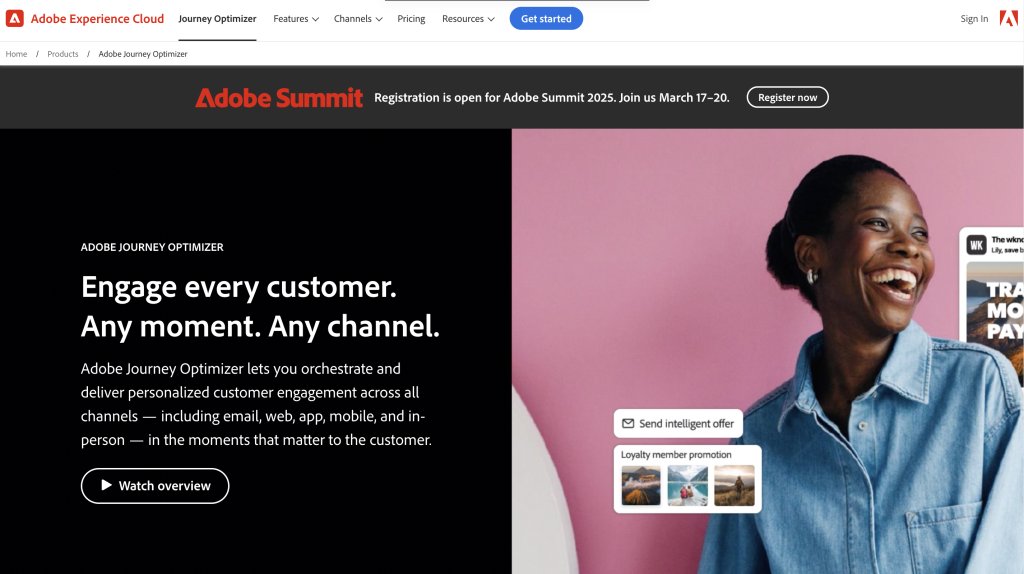
Features
Omnichannel personalization, real-time customer journey monitoring, drag-drop visual editor to HTML coding, native Adobe integration, and AI-powered real-time personalization based on user activity.
Pricing
Adobe Journey Optimizer offers three plans and the pricing for each is available on request.
Pros
- Unifies customer data from online, offline, and pseudonymous sources, enabling more precise personalization.
- User-friendly, with a visual editor that simplifies experience creation.
- Supports personalized inbound and outbound communication for a cohesive brand experience.
Cons
- An extensive feature set requires time to fully learn and leverage the platform’s capabilities.
- Lacks a centralized decision-making process, which may affect consistency.
- Visual rendering of journeys can be time-consuming.
3. Chartbeat
Chartbeat is a powerful content optimization and analytics tool that provides insights into your top-performing content and its key performance indicators (KPIs). It offers real-time visibility into content performance, along with a content recommendations engine. Additionally, Chartbeat tracks how the content recommendation performs, helping you fine-tune your content strategy effectively.
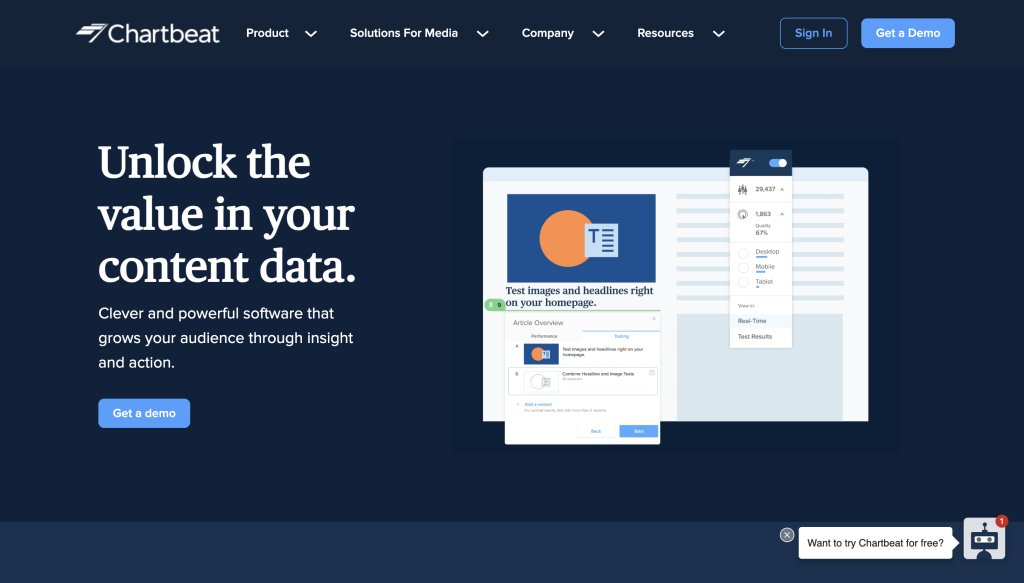
Features
Image testing, video performance tracking, headline testing, historical data dashboards, and real-time traffic analysis,
Pricing
Chartbeat offers three plans: Basic, Plus, and Premium. Pricing details for each plan are available upon request.
Pros
- Provides accurate, real-time analysis across all posts.
- Intuitive interface, easy to navigate with quick search functionality.
- Highlights the best-performing content by time of day and geography, enabling targeted optimization.
Cons
- Lacks trend insights that would benefit content-driven sites like news portals.
- Missing social post integration capabilities.
- Less effective for low-traffic websites, where data insights are limited.
4. Lighthouse
Lighthouse by Google is a performance analysis tool that audits a webpage’s speed, SEO, accessibility, and more. With just a quick installation of the Lighthouse extension on Chrome, users can easily evaluate any webpage.
The tool provides a score out of 100 for each key metric, including diagnostics, speed performance, and specific improvement opportunities. Lighthouse’s insights help users identify critical areas for optimization and fine-tune their website’s performance.
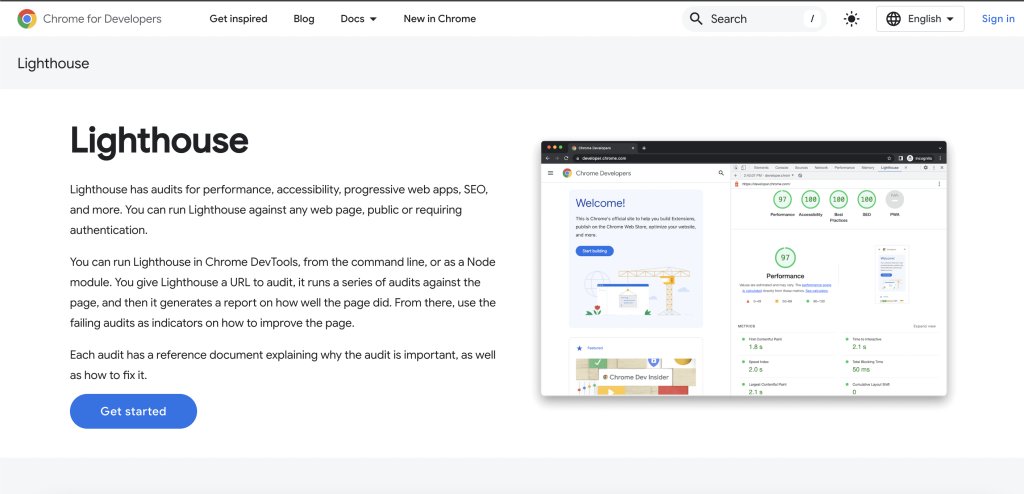
Features
SEO audit, best practice audit, website speed metric tracking, and accessibility audit.
Pricing
The tool is available for free.
Pros
- User-friendly with a clear, easy-to-read report structure.
- Free tool offering a comprehensive set of auditing features.
- Allows for quick auditing of any webpage or site without complex steps.
Cons
- Limited in scope for enterprise-level auditing needs.
- Provides recommendations but lacks tools for implementing those changes.
- Simulates user experience rather than analyzing real user interactions, which may introduce inaccuracies in the audit.
5. Screaming Frog
Screaming Frog SEO Spider is a robust on-page SEO tool that crawls websites to identify and resolve key SEO issues. Perfect for strengthening technical SEO, it provides a comprehensive overview of potential challenges and offers actionable insights to improve your site’s performance.
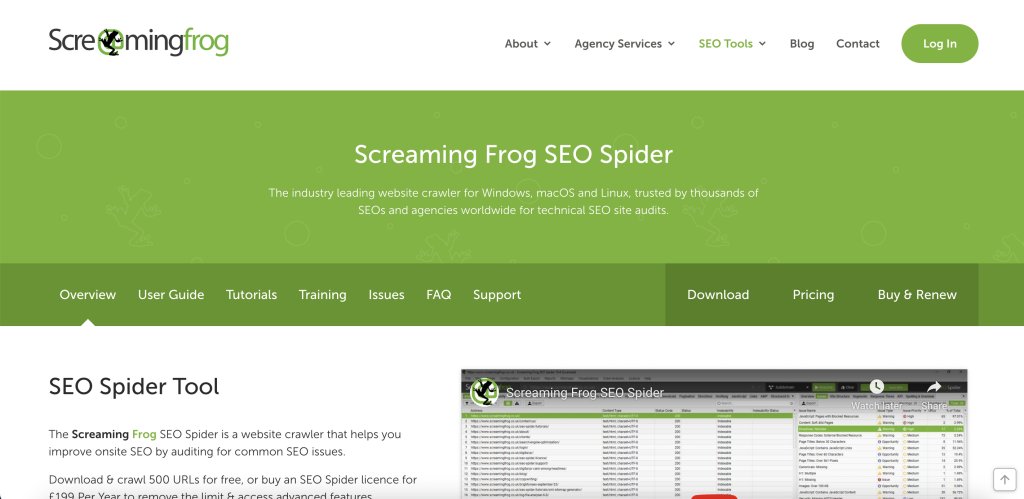
Features
Audit redirects, broken links finder, meta details analyzer, robots and directives review, site visualization, XML Sitemaps generator, near duplicate content review, and integration with Google suite of products.
Pricing
The tool offers two plans: a free version and a paid version. The free plan allows for audits of up to 500 URLs, while the paid plan provides unlimited URL crawling. The paid plan has advanced features like AMP crawling and OpenAI crawling capabilities—all for $259 per year.
Pros
- Offers in-depth on-page SEO insights, making it easy to identify and address page issues.
- User-friendly tool with multiple export options for efficient data management.
- High-speed crawling helps detect and resolve technical issues like duplicate URLs and 404 errors.
Cons
- Lacks a cloud-based storage solution, limiting accessibility and collaboration.
- Accuracy can diminish when crawling large websites, with occasional missed details or URLs.
- The user interface could benefit from more frequent updates to enhance usability.
6. Hotjar
Hotjar is a digital experience insights platform that reveals where users struggle on your website, enabling precise optimization strategies. It allows you to visualize and analyze user behavior, watch real interactions, and collect feedback from website visitors.
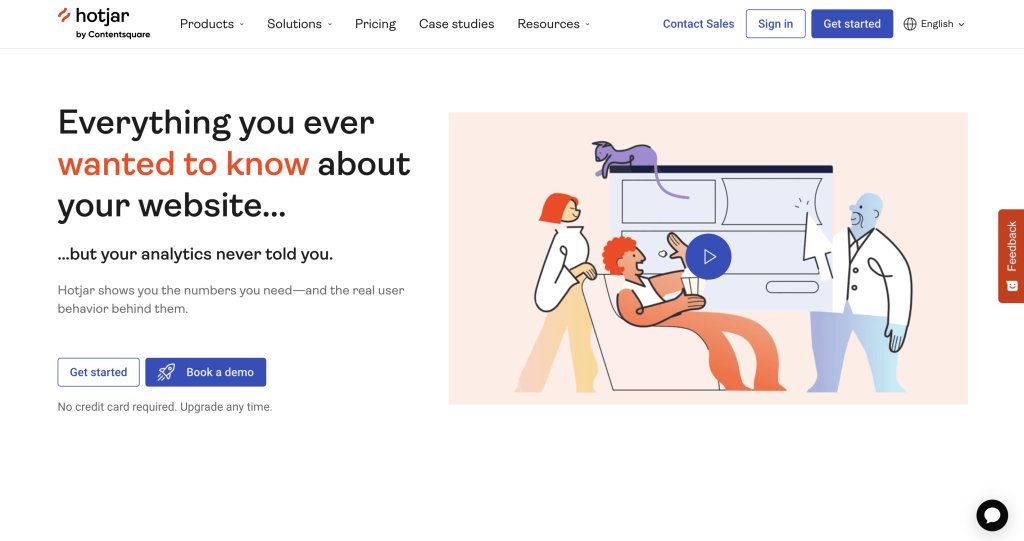
Features
Heatmaps, session recordings, 1:1 interviews, on-site surveys, a real-time suggestion box, integration with thousands of apps, conversion funnel analysis, and generative AI-powered survey creation.
Pricing
Hotjar provides straightforward and transparent pricing, with plans tailored to each capability. Pricing for all capabilities is $577 per month, billed annually.
Pros
- User-friendly interface offering a clear, comprehensive view of visitor behavior.
- Provides a complete picture of how users navigate through the website.
- Scalable, making it suitable for enterprise-level needs.
Cons
- Initially, the abundance of features can feel overwhelming.
- May cause a slight increase in website load time.
- Limited data retention period; upgrading your pricing plan is necessary to extend it.
7. WebPageTest
WebPageTest is a tool for website performance and optimization. It provides insights into how your webpage performs across different geolocations, networks, and devices. The detailed report highlights issues affecting page load speed, time to interactivity, and overall user experience. Additionally, it offers practical tips and suggestions to help improve performance.
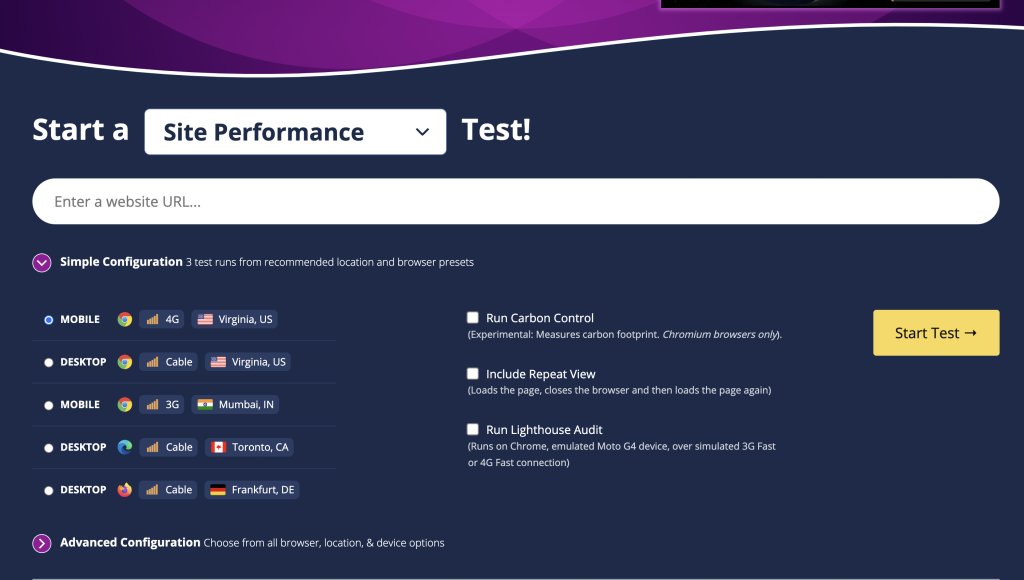
Features
Cor web vital testing, site performance test, visual comparison test of two URLs, no-code experiments, and 40+ geo-location tests.
Pricing
WebPageTest has a free starter plan and the paid plan starts at $180/year billed annually.
Pros
- WebPageTest allows testing across countless combinations of geolocations, devices, and networks, providing a comprehensive view of webpage performance.
- Users can bulk-test URLs, making the tool scalable for enterprise-level needs.
- The sandbox environment enables testing optimization measures and sees their impact on performance.
Cons
- There is a steep learning curve to fully interpret insights from the reports.
- Tool automation requires coding, which adds a dependency on the development team.
- While the reports offer valuable recommendations, they don’t explain how to implement them, leaving users to figure out the next steps on their own.
Additional tools for different aspects of website optimization
Here are some additional tools for different aspects of website optimization
Performance and speed optimization tools
1. Google PageSpeed Insights
What is it?
Google provides this free tool – Google Pagespeed Insights to analyze a web page’s performance and offer optimization suggestions for desktop and mobile devices.
What can it optimize?
Page load times, rendering performance, and overall website speed.
How can you use it?
Simply enter the URL of the web page you want to analyze, and PageSpeed Insights will provide a performance score and specific recommendations for improving its speed.
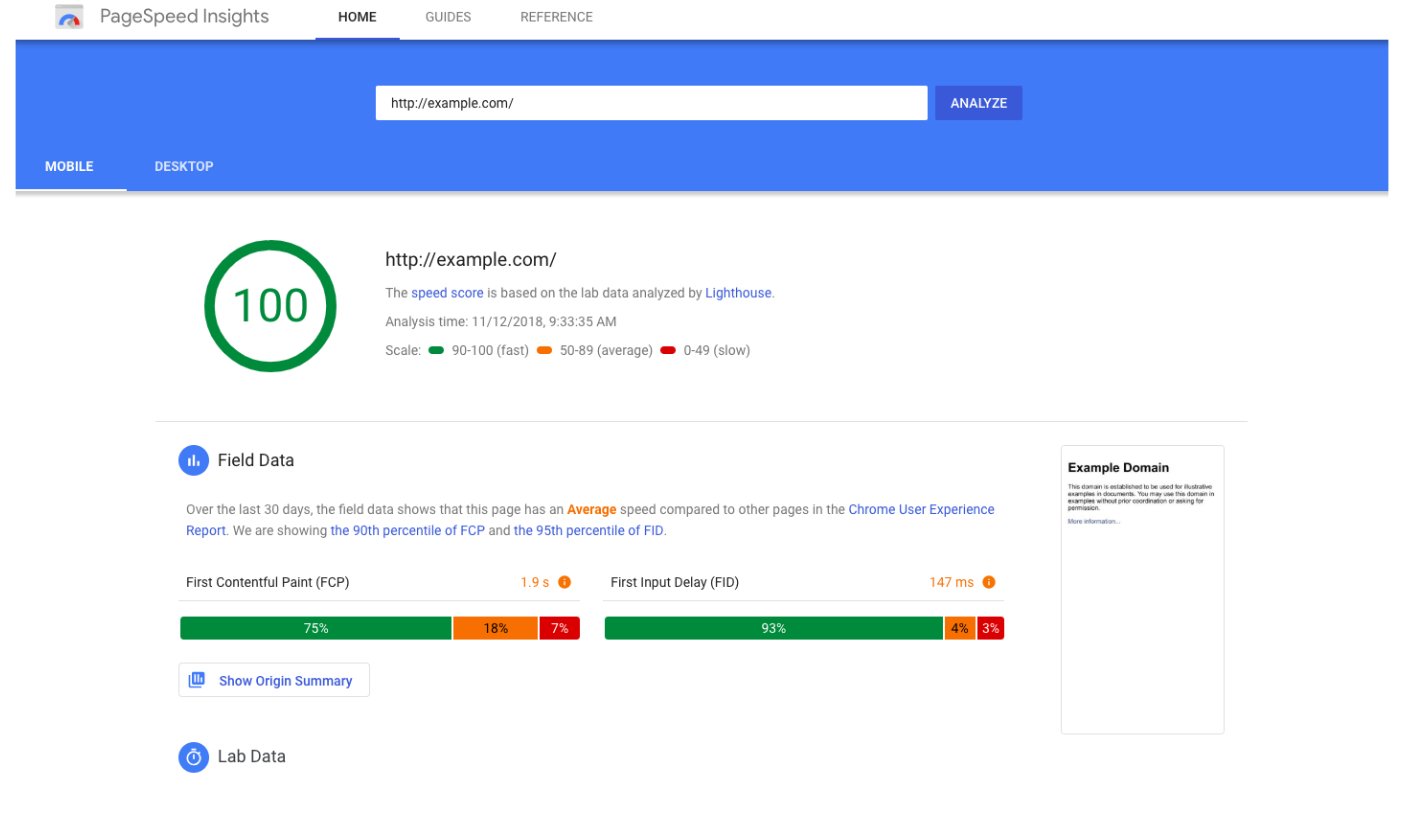
2. GTmetrix
What is it?
GTmetrix is a comprehensive website speed and performance testing tool that analyzes web pages and provides detailed reports and optimization recommendations.
What can it optimize?
Page load times, server response times, rendering performance, and overall website speed.
How can you use it?
Enter the URL of the web page you want to analyze, and GTmetrix will generate a detailed report with performance scores, Page Details, Waterfall View, and specific optimization recommendations.
Other noteworthy performance and speed optimization tools
- Pingdom
- YSlow
- Dareboost
Usability and user experience (UX) tools
1. Crazy Egg
What is it?
Crazy Egg is a user experience optimization software that provides heat maps, session recordings, and A/B testing capabilities to help identify website improvement areas.
What can it optimize?
User engagement, website navigation, content effectiveness, and conversion rates.
How can you use it?
Install the Crazy Egg tracking code on your website, and you can start capturing user behavior data through heatmaps and recordings. Use the A/B testing feature to test different variations and implement the winning version.
Other noteworthy usability and user experience tools
- FullStory
- UserTesting
Search engine optimization (SEO) tools
1. Ahrefs
What is it?
Ahrefs is a comprehensive SEO tool suite that provides data and insights for keyword research, backlink analysis, competitor analysis, ranking on Google search results, and website auditing.
What can it optimize?
Search engine visibility, organic traffic, and overall SEO performance.
How can you use it?
Use Ahrefs’s various features, such as Site Explorer, Keyword Explorer, and Content Explorer, to research keywords, analyze your website and backlink profile, monitor your competitors, and identify opportunities for improvement.
2. SEMrush
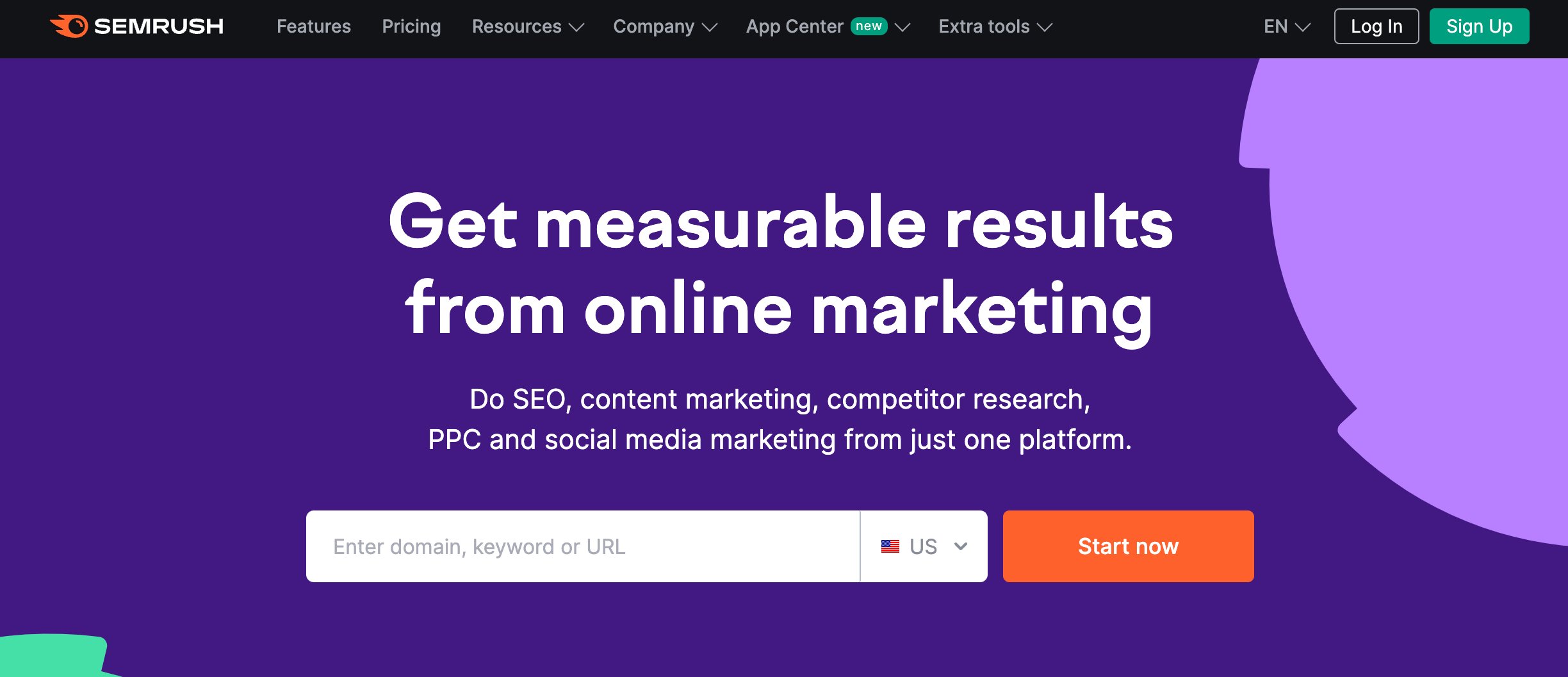
What is it?
SEMrush is an all-in-one marketing toolkit that provides SEO, PPC, social media, and content marketing analytics and insights.
What can it optimize?
Search engine visibility, organic and paid traffic, content marketing, and overall digital marketing performance.
How can you use it?
Utilize SEMrush’s various tools and features, such as keyword research with information on search volume and related keywords, search rankings, site audit, backlink analytics, and competitive intelligence, to improve your website’s SEO metrics, competitor research, and optimize your digital marketing strategies.
Other noteworthy SEO tools
- Google Search Console
- Moz Pro
- KWFinder
Conversion rate optimization (CRO) tools
1. Unbounce
What is it?
Unbounce is a landing page builder and optimization platform that allows you to create, publish, and test high-converting landing pages.
What can it optimize?
Conversion rates for various campaigns and marketing efforts include lead generation, product launches, and online sales.
How can you use it?
Create custom landing pages using Unbounce’s drag-and-drop builder, integrate with your existing marketing tools, and optimize conversion rates by leveraging features like A/B testing, pop-ups, and sticky bars.
Other noteworthy CRO tools
- Lucky Orange
- Convert
- Instapage
A/B testing and experimentation tools
1. Optimizely
What is it?
Optimizely is an experimentation platform that enables A/B testing, multivariate testing, and personalization across web and mobile applications.
What can it optimize?
Conversion rates, user engagement, and overall website performance through data-driven testing and personalization.
How can you use it?
Create and run A/B or multivariate tests by defining variations, setting goals, and targeting specific audiences. Analyze the results and implement the winning variations to improve performance.
Other noteworthy A/B testing and experimentation tools
- Adobe Target
- Unbounce (Landing Page Testing)
- Fresh Relevance
Website monitoring and uptime tools
1. Pingdom
What is it?
Pingdom is a website monitoring service that checks the uptime, performance, and availability of websites and web applications.
What can it optimize?
Website uptime, performance, and availability, ensuring a smooth user experience.
How can you use it?
Set up website or web application monitoring. Pingdom will continuously check for availability and performance issues and alert you when problems arise.
2. New Relic

What is it?
New Relic is a comprehensive application performance monitoring (APM) and observability platform that helps monitor and optimize the performance of websites, applications, and infrastructure.
What can it optimize?
Website and application performance, infrastructure optimization, and overall system reliability.
How can you use it?
Install the New Relic agent on your servers or applications. It will provide detailed monitoring and performance data, allowing you to identify and resolve issues, optimize resources, and ensure optimal performance.
Other noteworthy website monitoring and uptime tools tools
- Uptime Robot
- Dynatrace
- Datadog
- Sematext
Content optimization tools
1. Clearscope
What is it?
Clearscope is a content optimization platform that provides data-driven insights and recommendations to help create search-engine-optimized content.
What can it optimize?
Content quality, search engine visibility, and overall content performance.
How can you use it?
Enter a target keyword or topic, and Clearscope will analyze the top-ranking content, providing insights and recommendations for optimizing your content to outrank competitors.
2. MarketMuse
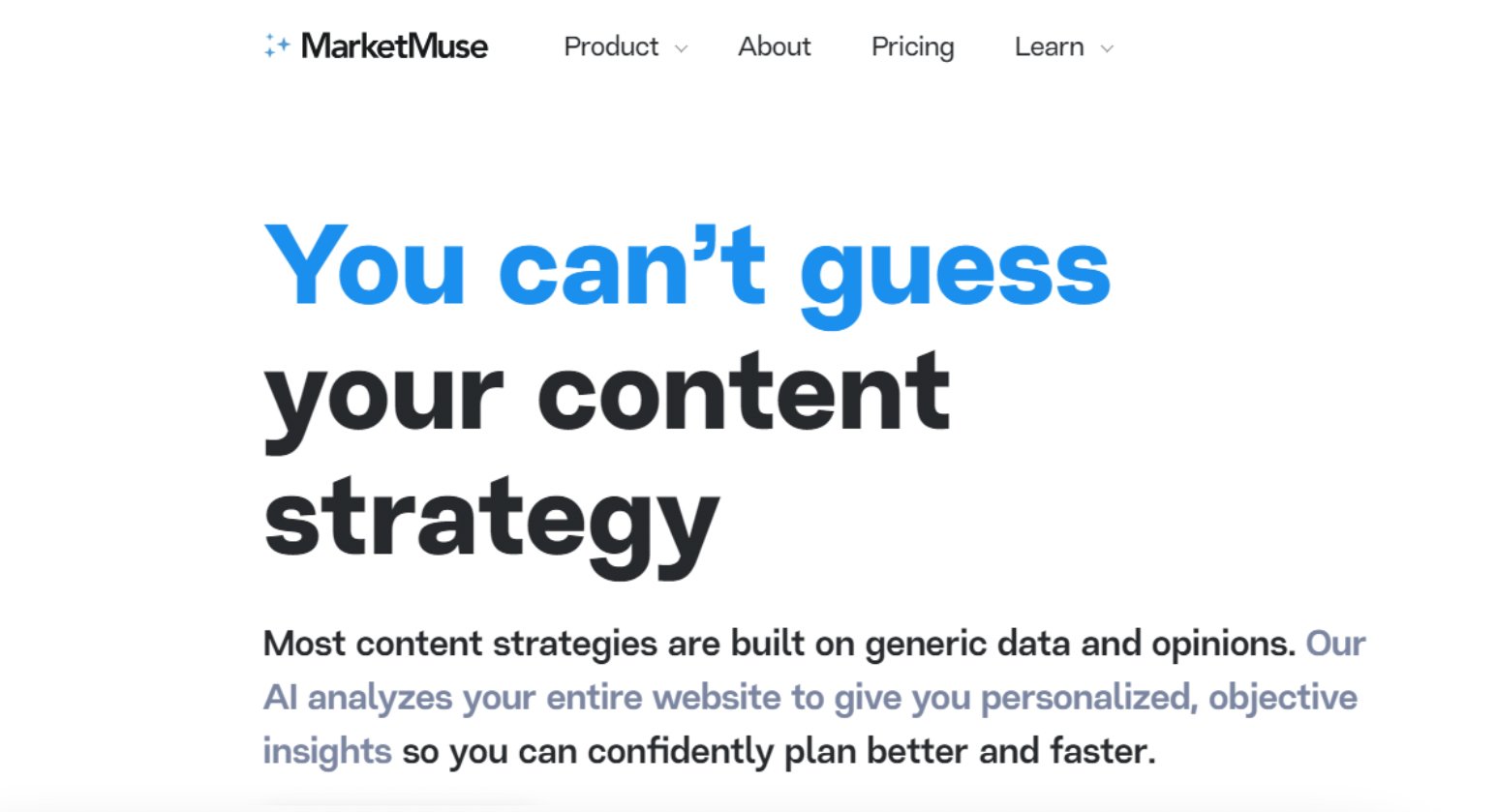
What is it?
MarketMuse is an AI-powered content optimization and planning platform that helps create high-quality, SEO-friendly content.
What can it optimize?
Content quality, search engine visibility, and overall content performance.
How can you use it?
Enter a target topic or keyword. MarketMuse will provide a content brief with recommendations for optimizing your content, including topics to cover related terms and semantic analysis.
Other noteworthy content optimization tools
- Frase
- Surfer SEO
- Yoast SEO (WordPress Plugin)
- SEO Monitor
Web analytics tools
1. Google Analytics
What is it?
Google Analytics is a free web analytics service that tracks and reports website traffic and user behavior.
What can it optimize?
Understanding user behavior, identifying areas for improvement, and making data-driven decisions for website optimization.
How can you use it?
Sign up for a Google Analytics account, add the tracking code to your website, and collect data on user behavior, traffic sources, conversions, and more. Analyze the data using the provided reports and dashboards.
2. Matomo (formerly Piwik)
What is it?
Matomo is an open-source, self-hosted web analytics platform that provides detailed insights into website traffic and user behavior.
What can it optimize?
It can understand user behavior, identify areas for improvement, and make data-driven decisions about website optimization while maintaining data privacy and control.
How can you use it?
Download and install Matomo on your server, add the tracking code to your website, and collect data on user behavior, traffic sources, conversions, and more. Analyze the data using the provided reports and dashboards.
Other noteworthy web analytics tools
- Adobe Analytics
- Mixpanel
- Heap Analytics
Mobile Website Optimization Tools
1. BrowserStack
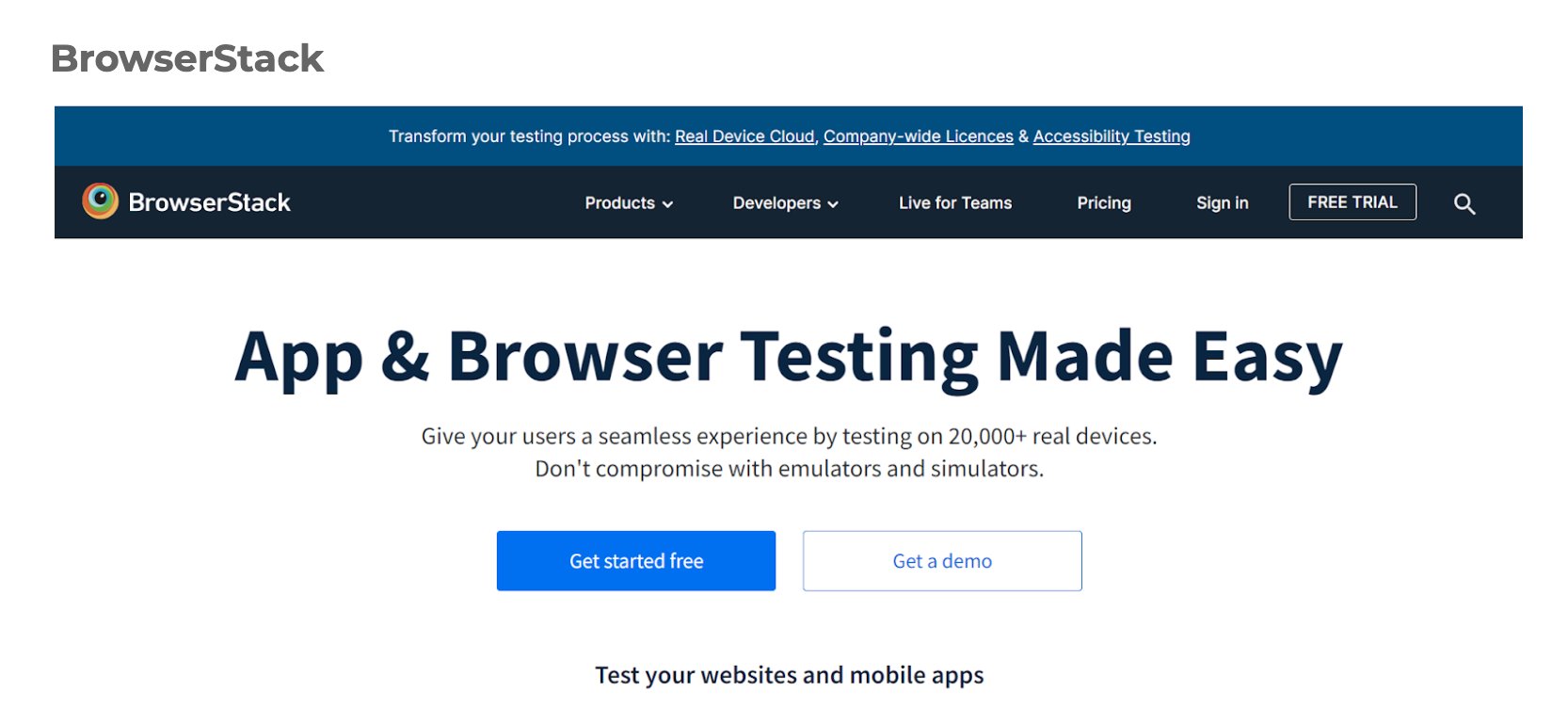
What is it?
BrowserStack is a comprehensive cloud-based testing platform that enables web developers to test their websites and mobile applications across a wide range of browsers and operating systems without additional infrastructure.
What can it optimize?
It ensures cross-browser compatibility, user experience consistency, and the functional integrity of websites and apps across various devices and platforms.
How can you use it?
Start by signing up for BrowserStack and integrating your development workflow with the platform. Then, select from an extensive list of browsers and devices to test your website or app. BrowserStack facilitates accurate device testing in live environments, providing instant interactive testing access to browsers and mobile devices. It also generates detailed reports to help identify and fix compatibility issues efficiently.
2. TestingBot
What is it?
TestingBot is a cloud-based cross-browser testing platform with mobile testing capabilities for various devices and platforms.
What can it optimize?
Mobile compatibility, responsiveness, and functionality across different mobile devices and operating systems.
How can you use it?
Create an account, upload your website or web app, and select the mobile devices and platforms you want to test. TestingBot will provide a virtual environment for testing and identifying issues or compatibility problems.
Other noteworthy mobile website optimization tools
- Perfmatters
- Chrome DevTools (Mobile Simulation)
Choosing the right website optimization tool
Choosing the right website optimization tool is vital for boosting user experience and reaching your digital goals. Here are some key features to consider when evaluating and selecting a tool:
1. Minimum impact on website speed
Many optimization tools require you to insert a tracking code in the <head> section of your web page, whether for audits, A/B testing, or personalizing user experiences. These tracking codes can slow down page load times, so prioritize tools that have minimal impact on website performance.
To assess the potential impact, utilize third-party testing tools or review the knowledge base of the tools you’re considering. This way, you’ll know exactly how each tool might affect your site’s speed—because optimizing your website shouldn’t come at the cost of a slow website.
2. Comprehensive feature set
Website optimization goes beyond improving a single aspect; it’s a comprehensive process that requires a focus on the entire website. Choosing a tool that enables you to address multiple facets of optimization can save time, reduce back-and-forth, and streamline the entire workflow.
Take VWO, for instance. It allows you to analyze user behavior, record observations, and convert these insights into hypotheses—all within a single dashboard. From there, you can seamlessly run A/B tests or implement any optimization strategy based on these hypotheses. This holistic approach not only saves time but also provides a cohesive view of your optimization efforts, empowering you to make informed, impactful changes.
3. Seamless integration with all major platform
When choosing a web optimization tool, seamless integration with your existing CMS or CRM is crucial to avoid data management headaches. Look for a platform with a robust integration library that connects effortlessly with your current digital tools. This not only saves time but also ensures a smooth fit into your existing tech stack, making the optimization process more efficient and hassle-free. Overall, it expands your scope of marketing activities by connecting data across platforms, enabling you to explore different strategies for better results.
4. Privacy compliant
With digital regulations tightening and a greater focus on privacy and data protection, it’s essential to prioritize tools that safeguard user data. You wouldn’t want to jeopardize your users’ data while optimizing your website, so ensure your chosen tool is compliant with regulations like GDPR, CCPA, and HIPAA. Ideally, opt for a tool that’s also SOC Type 2 certified, as this indicates it upholds rigorous security protocols and consistently applies best practices to protect sensitive data.
5. Free trial or plan
Investing in an optimization tool requires a considerable commitment of money, time, and resources. To minimize risk, choose tools that offer an ample free trial period or a forever-free plan with essential features. This allows you to thoroughly assess the tool’s capabilities and see how well it aligns with your business needs. By testing upfront, you gain confidence in the tool’s potential to deliver a positive ROI, ensuring you’re making a well-informed investment.
Final thoughts
To wrap up, website optimization is undeniably crucial for securing online success. Looking ahead, the role of website optimization tools in shaping digital strategies is set to grow even more critical in making websites more accessible, faster, and more engaging for users.
Understanding the different types of website optimization tools, their capabilities, and how to use them effectively can help you identify areas for improvement, implement data-driven strategies, and continuously optimize your website to meet evolving user expectations and business goals.
Take the first step towards digital success with VWO’s advanced optimization tools. Experience the VWO impact—start your free trial today and transform your website’s potential into performance!











